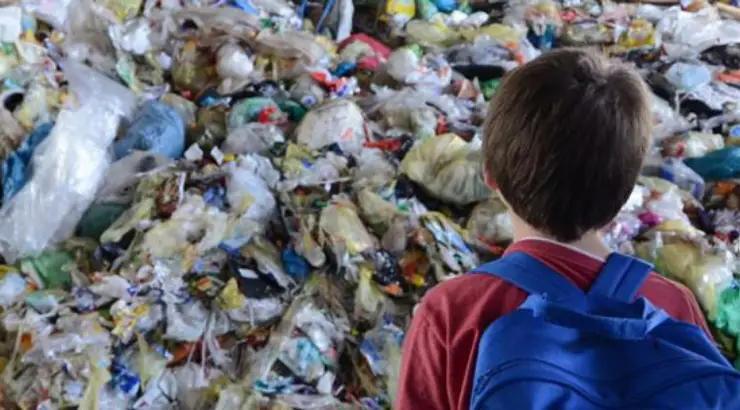Environment
‘Staggering’ Scale of Waste: Billions of Dollars in Online Clothing Returns Go Straight to Landfills
Even unsold items that haven’t been touched by a consumer are being trashed.

(TMU) — We all know that consumerism is a force that’s destructive to the environment, but too frequently the blame is placed on cultural factors — for example, our personal habits as consumers.
However, the enormous burden placed on the environment is primarily due to the actions of the large corporations that manufacture and sell consumer goods like clothing.
The waste generated by the fashion industry is no secret. Even clothing industry magnate and designer Eileen Fisher famously admitted that “the clothing industry is the second-largest polluter in the world … second only to oil.”
However, according to Adria Vasil, an environmental journalist and chief editor of Corporate Knights magazine, the boom in online retailing over recent years has led to a shocking amount of perfectly decent clothing ending up in dumpsters and landfills.
If you’ve ever ordered a range of clothing online only to try it on and return those articles that don’t fit—Amazon.com doesn’t really have a dressing room, after all—you may be shocked to learn that those items you’ve returned go right into the trash. Vasil explained to CBC Radio:
“We’re buying more of our clothing online, but it’s actually hard because you don’t really know exactly the sizing. So what many of us are doing is called bracketing. We will buy a medium, small and large or, you know, an 8, 10 and 12, and try them all on and then return the two that don’t fit. Problem is, the two that we return are actually, in many cases, being landfilled. And the brands do not want to deal with those returns. So they’d rather just dump them.”
For online clothing companies, it’s just a matter of ensuring corporate profits. Vasil added:
“It actually costs a lot of companies more money to put somebody on the product, to visually eyeball it and say, is this up to standard, is it up to code? Is this going to get us sued? Did somebody tamper with this box in some way? And is this returnable?
And if it’s clothing, it has to be re-pressed and put back in a nice packaging. And for a lot of companies, it’s just not worth it. So they will literally just incinerate it, or send it to the dumpster.”
Here’s an idea: Let’s all go to Victoria Secret and buy their bras and clothing and then return them. They destroy everything returned because it’s their “company policy”. Then they lose a bunch of product and money. ?? #BoycottVS
— Tiffany Alex (@TrashyTiffany) November 11, 2018
For those who are environmentally conscious, the wastefulness of the practice should be enraging. According to the United Nations, the multi-trillion dollar fashion industry produces roughly 10 percent of the world’s greenhouse gas emissions due to its expansive global supply chains and energy-intensive production processes. That t-shirt you’re wearing for a local band or sports team probably traveled halfway across the globe in a Maersk container ship running on fossil fuels.
In the meantime, cotton—and especially organic cotton—requires over 5,000 gallons (20,000 liters) of water just to manufacture one t-shirt and a pair of jeans, according to the World Wildlife Fund. The UN also reports that cotton farming is responsible for 24 percent of insecticides and 11 percent of pesticides despite only using 3 percent of the world’s arable land.
https://twitter.com/franceintheus/status/1163543978496667648
Even unsold items that haven’t been touched by a consumer are being trashed. In 2018, luxury fashion brand Burberry admitted that it junked about £90 million ($120 million USD) of clothes and accessories in the five years prior. Following public outcry, it halted the policy. Vasil explained:
“We’re seeing so many clothing brands, in particular, throwing out or incinerating clothes, as Burberry did. They were caught burning billions of dollars of clothes. H&M as well. And it was a scandal, you know, for people in the clothing industry. Finding out, if you’re a shopper, that billions of dollars are being burned because they do not want this ending up on the market, and undervaluing their clothes on shelves this year.”
When asked why companies don’t simply give their clothes to charities, Vasil noted that it may compromise the nature of certain brands as status symbols. She said:
“It’s an image thing. They’re trying to maintain exclusivity. They’re trying to maintain kind of the specialness of their product. But it’s really symptomatic of a larger issue with kind of our consumer culture right now.”
https://twitter.com/Rumblebun/status/1205478045550862338
However, some brands are fighting back against the wasteful practice. Patagonia, in particular, has established online and physical retail spaces dubbed “Better Than New” where slightly worn or defective clothing is repaired and resold. Meanwhile, France—which is home to several high fashion brands—banned the practice of destroying unsold consumer products this year.
Vasil recommends that rather than purchasing clothing we know we’ll return, we should instead consider donating. And if that sounds too expensive, we should consider buying our clothes at a thrift store. She said:
“A lot of us are buying new goods that we don’t really need. And there is an increased trend in second-hand shopping right now.
And so I would encourage you to partake in it and to look for brands that are actually part of the circular economy, that are, like Patagonia, repairing, refurbishing and fixing goods at the end of their life so that they can have a second life.
And so that we do not end up with so much waste.”
By Elias Marat | Creative Commons | TheMindUnleashed.com
Typos, corrections and/or news tips? Email us at Contact@TheMindUnleashed.com
